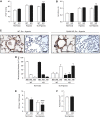RNA Sequencing Analysis Detection of a Novel Pathway of Endothelial Dysfunction in Pulmonary Arterial Hypertension
- PMID: 26030479
- PMCID: PMC4584250
- DOI: 10.1164/rccm.201408-1528OC
RNA Sequencing Analysis Detection of a Novel Pathway of Endothelial Dysfunction in Pulmonary Arterial Hypertension
Abstract
Rationale: Pulmonary arterial hypertension is characterized by endothelial dysregulation, but global changes in gene expression have not been related to perturbations in function.
Objectives: RNA sequencing was used to discriminate changes in transcriptomes of endothelial cells cultured from lungs of patients with idiopathic pulmonary arterial hypertension versus control subjects and to assess the functional significance of major differentially expressed transcripts.
Methods: The endothelial transcriptomes from the lungs of seven control subjects and six patients with idiopathic pulmonary arterial hypertension were analyzed. Differentially expressed genes were related to bone morphogenetic protein type 2 receptor (BMPR2) signaling. Those down-regulated were assessed for function in cultured cells and in a transgenic mouse.
Measurements and main results: Fold differences in 10 genes were significant (P < 0.05), four increased and six decreased in patients versus control subjects. No patient was mutant for BMPR2. However, knockdown of BMPR2 by siRNA in control pulmonary arterial endothelial cells recapitulated 6 of 10 patient-related gene changes, including decreased collagen IV (COL4A1, COL4A2) and ephrinA1 (EFNA1). Reduction of BMPR2-regulated transcripts was related to decreased β-catenin. Reducing COL4A1, COL4A2, and EFNA1 by siRNA inhibited pulmonary endothelial adhesion, migration, and tube formation. In mice null for the EFNA1 receptor, EphA2, versus control animals, vascular endothelial growth factor receptor blockade and hypoxia caused more severe pulmonary hypertension, judged by elevated right ventricular systolic pressure, right ventricular hypertrophy, and loss of small arteries.
Conclusions: The novel relationship between BMPR2 dysfunction and reduced expression of endothelial COL4 and EFNA1 may underlie vulnerability to injury in pulmonary arterial hypertension.
Keywords: collagen IV; ephrin; pulmonary hypertension; transcriptome; vascular endothelium.
Figures




References
-
- Teichert-Kuliszewska K, Kutryk MJ, Kuliszewski MA, Karoubi G, Courtman DW, Zucco L, Granton J, Stewart DJ. Bone morphogenetic protein receptor-2 signaling promotes pulmonary arterial endothelial cell survival: implications for loss-of-function mutations in the pathogenesis of pulmonary hypertension. Circ Res. 2006;98:209–217. - PubMed
Publication types
MeSH terms
Substances
Grants and funding
LinkOut - more resources
Full Text Sources
Miscellaneous

